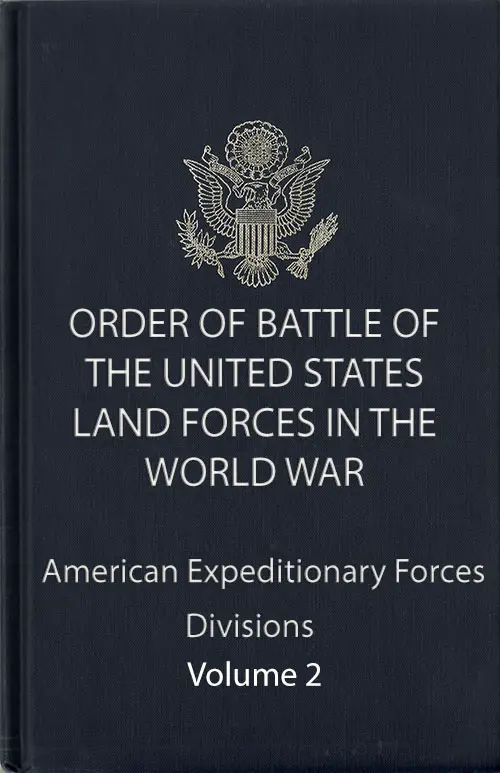Order of Battle, Volume 2: American Expeditionary Forces: Divisions - 1937

U.S. Government Printing Office, Order of Battle of the United States Land Forces in the World War, Volume 2, American Expeditionary Forces: Divisions © 1937/1988, Center of Military History, United States Army, U.S. Government Printing Office, Hardcover, 451 Pages. 940.4'12'73. cover of book is dark blue with insignia of the United States but no lettering. Title on Binding.
Subject: United States, Army -- History -- World War, 1914 - 1918.
Synopsis
Volume 2 provides outline histories of the AEF's divisions. The essays combine information about the command and composition of units with tables that offer the reader a broad survey of operations in major and minor theaters and the rear areas.
Preface
The purpose of this work by the Historical Section of the Army War College is to present the essential facts of the participation of the land forces of the United States in the World War. It deals with the command, composition, and operations of large units.
This volume contains outline histories of the divisions which served in Europe during the war. Original sources, the majority of which are official papers of the War Department, form the basis. The source references are on me in the Historical Section of the Army War College.
The command lists were compiled for this publication by The Adjutant General. The front lines of the divisions during battle are based primarily on a series of special studies by the American Battle Monuments Commission and an analysis by the Historical Section of the original material on me in the War Department.
The lists of the attached and detached units are limited to the larger combat echelons; units smaller than a regiment or independent battalion are not shown unless they were engaged in combat.
The dates of attachment or detachment usually appear, but in a number of cases only the actual battle participation while present, or detached, is recorded.
Credit for participation in an operation is given a division from the time it entered corps reserve, provided the operation was in progress, or when it assumed command of a front without passing through corps reserve.
Battle participation is shown as continuous when a division passed from a place in the line to corps reserve and then returned to the line; but any interruption in this sequence terminates the participation in that operation.
The dates of sector occupation, when American troops were affiliated with Allied troops for training, are fixed by the entry into line of the first American unit and the departure from the line of the last American unit.
However, when an American division entered a sector to relieve another organization or assumed command of a sector in which it was affiliated with Allied troops, the dates of the sector occupation are governed by the passing of command.
The assignments show the armies and corps with which the divisions served. The arrival of the headquarters governs the date of entry into an area. Current orders furnish the dates of service in army reserve.
A unit appears in corps reserve only pursuant to formal orders and if the unit was sufficiently accessible to be able to influence the action; the period of this service usually began with an operation unless one was already in progress. In routine moves behind the lines, the move of the first unit is used to indicate the departure of the division.
The figures after the designation of artillery troops show the caliber of their equipment in millimeters, unless otherwise indicated. Activities of detached units and periods of administrative control are shown in brackets.
Descriptions are based on the French 1:20,000-scale maps, "Plans Directeurs."
There are certain phrases used, for the sake of brevity, to indicate special conditions.
The artillery brigade and its train were frequently detached from the division, and this situation is indicated by the phrase "less artillery.’,
"Administrative control" indicates supervisory authority, but not tactical command.
"Front line" indicates the general line which was held in force against the enemy.
"Elements in line" indicates that troops were in the front line but were under the command of another organization. This practice was common for training purposes.
"In line" indicates that the command of a sector of the front line was held by the organization concerned. Several days may have been required to effect the relief of the preceding unit prior to the passage of command.
"Rear area" indicates that the organization was within the corps or army area but was neither in line nor specifically designated as a reserve.
"In area" indicates that the units were not in proximity to the front lines. They may have been in training areas, or in other localities behind front-line troops, as were units of the First Army after the advance of the Third Army on November 17,1918.
Contents:
- Regular Army Divisions
- National Guard Divisions
- National Army Divisions
- Composition of Divisions
- Tables of Organization of Divisions
- Calendars (1917-1919)
- Abbreviations
Library of Congress Catalog Listing
- LC Control No.: 87600306
- Type of Material: Book (Print, Microform, Electronic, etc.)
- Main Title: Order of battle of the United States land forces in the World War.
- Published/Created: Washington, D.C. : Center of Military History, United States Army, 1988.
- Related Names: Center of Military History.
- Description: 3 v. in 5 : ill., col. maps; 24 cm.
- Contents: v. 2. American Expeditionary Forces : divisions
- Notes: Reprint. Originally published: Washington : U.S. G.P.O., 1931-1949. Includes indexes.
- Subjects: United States. Army --History --World War, 1914-1918.
- LC Classification: D570 .O73 1988
- Dewey Class No.: 940.4/12/73 19
- Government Document No.: D114.2:B32
- Geographic Area Code: n-us---
